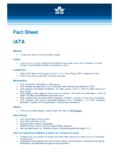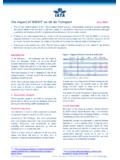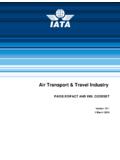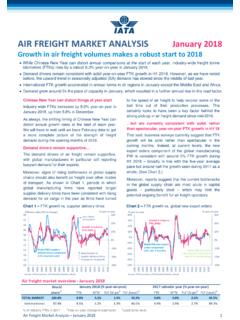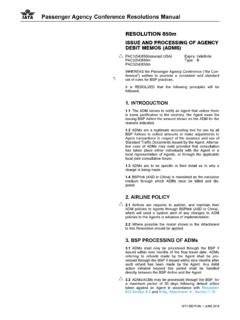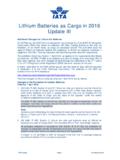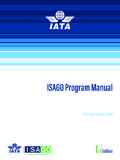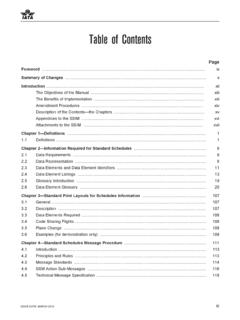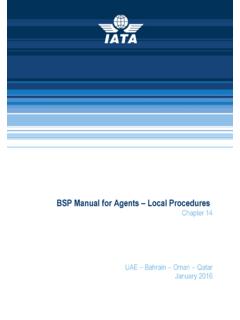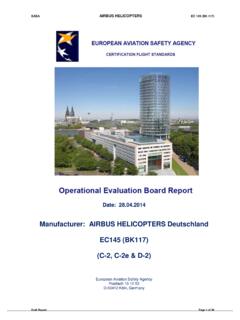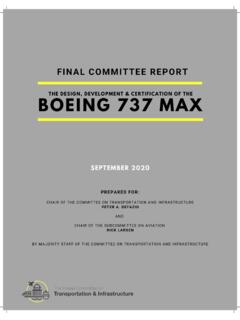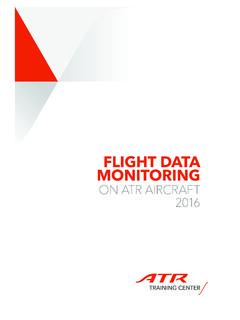Transcription of Electronic Shipper’s Declaration for Dangerous Goods (e ...
1 Electronic Shipper s Declaration for Dangerous Goods (e-DGD) Implementation Guide 2 Version control Version Date Status Author Summary of changes 07 JUN2017 initial Dr. Philipp Billion Initial 09 AUG2017 extended Extensions 14 AUG2017 extended As template for e-DGD Working Group 04 SEP2017 extended Extensions 11 SEP2017 extended Sarah Idir, Beverly Seebach, Ying Lu Added content sent in via Email 27 SEP2017 extended e-DGD PoC WG Input from working Group Meeting processed 13 OCT2017 extended Dr. Philipp Billion Further completion 01 NOV2017 extended Dr. Philipp Billion / e-DGD PoC WG Further additions / corrections based on the results of the F2F-Meeting in BSL 05 DEC2017 extended e-DGD PoC WG Further additions / corrections (not completed yet) 27 DEC2017 extended Dr.
2 Philipp Billion / e-DGD PoC WG Adjustments to the use of XFSU-DIS 29 JAN2018 extended e-DGD PoC WG 06 FEB2018 extended Dr. Philipp Billion / e-DGD PoC WG Adjustments to the use of XFSU-DIS use of errors after alignment with DG experts 06 JUN2018 extended e-DGD PoC WG 13 AUG2018 extended Dr. Philipp Billion Change to XFSU DIS data elements according to feedback from IATA CMWG 13 AUG2018 Extended e-DGD PoC WG Input from e-DGD F2F-Meeting #14 13 AUG2018 extended Dr. Philipp Billion 08 NOV2018 extended Dr. Philipp Billion Principles for the PoC included , 22 NOV2018 extended e-DGD PoC WG Minor adjustments 11 DEC2018 extended e-DGD PoC WG Final adjustments based on feedback of IATA DG experts 11 DEC2018 extended e-DGD PoC WG Formatting change 12 DEC2018 extended Jacinthe De Oliveira Added table of correspondence with Appendix B 3 Table of Contents 1.
3 Introduction .. 4 General Introduction .. 4 Background .. 4 Objectives .. 4 2. e-DGD principles .. 4 Business process .. 4 e-DGD Data platform .. 4 Identification and data exchange practice .. 5 3. Business Process Requirements .. 5 Standard Process .. 5 Process variations .. 6 Additional requirements .. 6 4. Technical specification of message and data fields .. 7 Shipper s Reference ID .. 7 XSDG .. 8 XFNM .. 9 FSU/XFSU-FOH (Freight on Hand at airline) .. 9 FSU/XFSU-RCS (Ready for Carriage at airline) .. 10 FSU/XFSU-DIS (Airline Dangerous Goods acceptance check failed) .. 10 Digital accompanying documents .. 12 5. Airline s requirements to platform .. 14 Station configuration list.
4 14 6. Irregularities process .. 14 Change of AWB Number by forwarder in the directly assign -process .. 14 7. Improvement potential .. 14 Communication of reopening of update channel .. 14 Using the IATA matchmaker infrastructure for carrier capabilities .. 14 4 1. Introduction General Introduction Digitization currently is a focus topic for the air transport supply chain. There is a strong momentum of major stakeholders heading for digitizing the supply chain partially or holistically. The implementation of the digital processes for Dangerous Goods (DG) is considered to be promising in terms of benefits. The current approach to digitize the Shipper's Declaration for Dangerous Goods (DGD) is community-driven it is not based on airlines , forwarders or shippers engagement solely.
5 As this can only be successful when all stakeholders participate, this starting point seems most fitting for an effective implementation. The goal of these activities by the stakeholders of the supply chain is to provide a digital environment for DG shipments, where DG data is created once and then shared throughout the supply chain. In addition to many other bene-fits, this solution will prevent re-capturing of DG data at any stage and raise data quality with extensive quality checks. The airline industry s task is to support the community approaches with in-depth know-how about airline s processes and experience gathered in digitization of the cargo documents.
6 Background The IATA e-DGD initiative began at the end of 2016 with the establishment of the Electronic Shipper s Declaration for Dangerous Goods (e-DGD) Proof of Concept Focus Group including three airlines and one ground handling agent (Air France Cargo, Lufthansa Cargo, SWISS World Cargo and Cargologic), who had recognized the momentum of the industry to move forward. These actors see the need for the paperless process among various stakeholders in the air cargo supply chain and are contributing to three non-related DG-community driven projects: - e-DGD by Cargo Information Network (CIN) in CDG; - INFr8-DGD by Dakosy / Fraport in FRA; - e-DG App by IGAC Switzerland in ZRH. Objectives The goal of this document is to define requirements and provide a guide for data sharing platforms, airlines , shippers, freight forwarders, ground handling agents (GHA) and other stakeholders that want to integrate an e-DGD functionality.
7 The document is based on the learnings from the e-DGD pilot projects during their runtime in 2018. The standard will be updated continuously to adopt new requirements and integrate further improvements. In terms of standardization, this implementation guide will ensure the consistency of the business processes, define the data flow and validate the XML e-DGD (XSDG) message. The content of this e-DGD implementation guide is intended to be used as guidance material for stakeholders who wish to implement the use of the e-DGD. This document complements Resolution 618, IATA Dangerous Goods Regulations (DGR) Manual and all of the existing regulations therein remain applicable.
8 2. e-DGD principles The e-DGD principles are intended to provide a guideline to the basic approach of e-DGD. Business process The set of the business process rules aims to clarify the e-DGD process and enforce a compliant process. Strictly paperless process If a shipment uses the Electronic transmission for submitting the DGD (based on the existence of an Electronic e-DGD message), a paper version of the DGD shall not be accepted or considered. Single process Should the routing (transit, destination) require a paper version of the DGD, the airline or the GHA on behalf of the airline shall print the document (Single Process). The format of the printed document shall comply with the IATA standard set out in DGR Section 8.
9 No mixed consolidated shipments When consolidating Dangerous Goods shipments, the forwarder shall not mix shipments with paper DGD and e-DGD. It shall be either a consolidation of shipments with paper DGD only or shipments with e-DGD only. e-DGD Data platform The digitization of the DGD requires collaboration of the supply chain stakeholders through participation on a data platform, whether local, national, regional or international. 5 Roles and responsibilities e-DGD creation, modification, cancellation and use shall be restricted to parties according to permissions (shipper / freight forwarder / airline / GHA / 3rd party). The data platform should validate the training expiration of the users for all parties acting with it and shall be administered by each party.
10 Print of e-DGD Data An Electronic copy of the e-DGD (non-editable pdf) should be made available based on the latest version of the data. The signature(s) may be Electronic signature(s) or may be re-placed by the name(s) (in capitals) of the person authorized to sign, unless facsimile signature is required by the local applicable laws and regulations. Data freeze The shipper will be able to modify the signed/finalized e-DGD data until the point where the next party has started to work with the data. After this point, a recall mechanism can only be carried out outside of the portal by other means of communication. All the mandatory e-DGD data supplied on the data platform must be frozen prior to the Dangerous Goods acceptance check.
